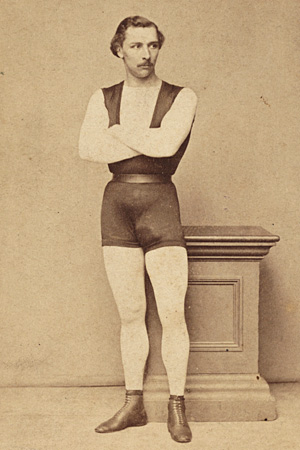The First Public performance by Jules Leotard
“The Daring Young Man on the Flying Trapeze’
- 12th November 1859 -
 The ‘Circus’ itself is of comparatively modern origin though elements of it go right back to ancient times. The Romans themselves had amphitheatres called Circuses after the Latin word for round – ‘Circum’. These were more for gladiatorial combats, chariot races, mock battles and blood sports rather than the more family friendly entertainment we associate with the circus today. The most famous of these were the Colosseum and Circus Maximus in Rome itself. The latter was a chariot-racing track.
The ‘Circus’ itself is of comparatively modern origin though elements of it go right back to ancient times. The Romans themselves had amphitheatres called Circuses after the Latin word for round – ‘Circum’. These were more for gladiatorial combats, chariot races, mock battles and blood sports rather than the more family friendly entertainment we associate with the circus today. The most famous of these were the Colosseum and Circus Maximus in Rome itself. The latter was a chariot-racing track.
Acrobatics, balancing acts and juggling have records dating back to Ancient Egypt and 2500BC. The Greeks practised rope dancing and early African civilisations performed ‘Siricasi’ ,a mixture of folk dances and acrobatics. In Ancient China jugglers and acrobats performed for the Imperial Court.
Rather than being organised into one event these troupes wandered the various continents of Europe, Africa and Asia performing and getting paid. We know that in the ninth century Alfred the Great was entertained by a wild beast show and in the eleventh century William I, the Conqueror, brought ropedancers, tumblers and contortionists over from Normandy to perform in England.
Fairs, which were crucial to trade, started to develop entertainment to run alongside and bring more people to the event. These fairs became a showcase for acrobats, animal shows and feats of human skill but by the eighteenth century they had become rather unsavoury places and home to pickpockets, thieves and vagabonds.
The modern circus came to England in 1768 when Philip Astley, a sergeant major, turned trick rider, found that by riding in circles the various forces helped him keep his balance. This is credited with the circus ring. Originally 19m in diameter this then had a roof put over it to keep people and performers dry. The size was then reduced to 13m, which is still the size of a circus ‘top’ today. In 1770 clowns were introduced as well as musicians and then feats of human skill in the nineteenth century.
Jules Leotard was born in 1842 and was a bright performer at school. He looked destined for a career in the Law. However his dad was a gymnastics teacher in Toulouse and also owned a pool. By the age of 18 Jules became more and more fascinated in acrobatics and experimented swinging on trapeze bars, ropes and rings over his father’s lido.
He joined the Cirque Napoleon and made his first public performance as a trapeze artist on November 12th 1859. He became the first person to perform a somersault in mid-air and to jump from one trapeze to another. His 12-minute act included high leaping between 3 trapezes and somersaulting to a carpet-covered safety mat. So impressed were his co-artists that they gave a dinner in his honour and struck a commemorative medal.
In May 1861 he made his debut in London at the Alhambra Theatre, Leicester Square in a music hall setting, performing his act over the heads of the diners. He became a massive superstar and was paid £180 a week (£5000 in today’s money). To help him in is act he designed and wore a skin-tight, one-piece garment with long sleeves, which was knitted. He called it a ‘maillot’, which means swimsuit/jersey in French today. This outfit allowed him both freedom of movement and an ability to show off his muscular physique – making him a real hit with the ladies. Eventually this piece of clothing found its way into the ballet and the first recorded use of it in English ballet circles was in 1886.
Unfortunately Jules Leotard died aged just 28 in Spain from either Smallpox or cholera. His name though goes on in history both for his outfit but also in the lines of a well-known music hall song written by George Leybourne.
He’d fly through the air with the greatest of ease
A daring young man on the flying trapeze.
His movements were graceful
All girls he could please
And my love he purloined away.”


